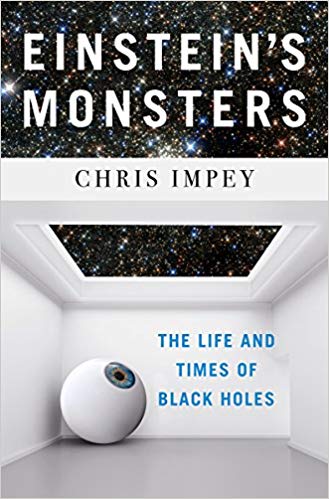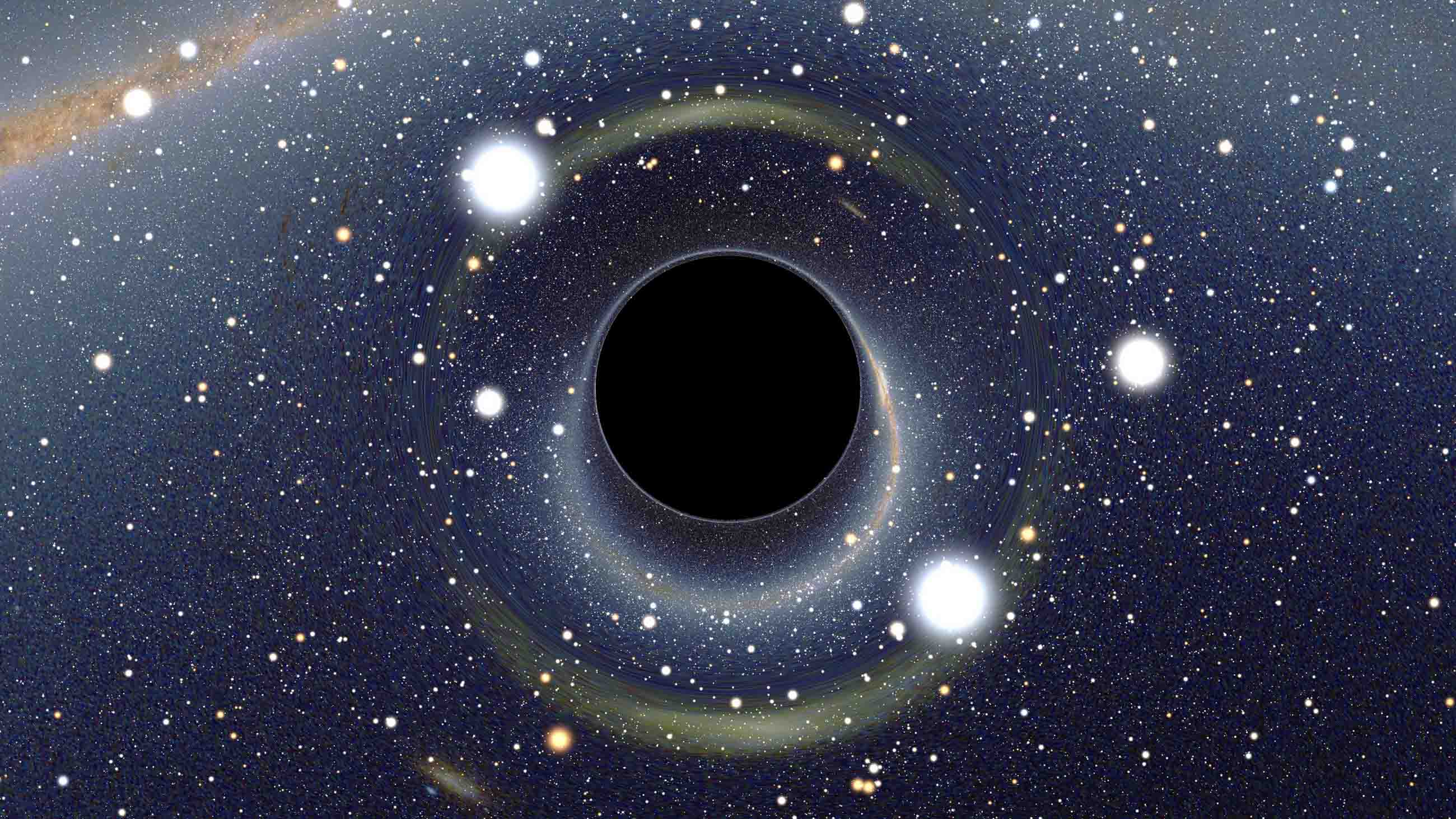If Stephen King had chosen astrophysics for a career, odds are good that he’d be studying black holes. They’re astronomy’s greatest horror show. Consider if you fell into one: “The stretching force of gravity would ‘spaghettify’ [you],” writes Chris Impey in “Einstein’s Monsters: The Life and Times of Black Holes.” “You would be stretched at the level of muscle fibers and cells and strands of DNA,” he added. In other words, ripped apart in an instant. It’s this horrifying prospect that has made books on black holes so popular.

BOOK REVIEW — “Einstein’s Monsters: The Life and Times of Black Holes,” by Chris Impey (W. W. Norton & Company, 304 pages).
But if you haven’t got around to reading one as yet, Impey’s book offers one-stop shopping: a superb summary of the history of black holes, their varied sizes, observational proof of their existence, and their significance to the universe at large. More important, the reader gets not only the science but the human story as well: “A reminder,” notes Impey, “that while science is dispassionate, scientists are made of flesh and blood, with all the flaws and foibles that entails.” (That includes his own chilling moment in Russia when, heading to the border with Georgia to get dry ice for an instrument, two men got into the car on either side of him, toting guns.)
Black holes are the most terrifying result to come out of the momentous general theory of relativity, forged by the 20th century’s greatest physicist (hence the book’s title). But Einstein didn’t come to that realization; the German astronomer Karl Schwarzschild discovered the shocking possibility while being the first to fully solve Einstein’s equations without approximations. Calculating amid the gunfire while serving on the Russian front in World War I, he saw that if a star like our Sun were squeezed to a point (what he called a “singularity”), a gravitational boundary would surround it, forever trapping what was inside — not just matter but also light.
Yet for decades, few took this result seriously, because astronomers were sure that no star could possibly shrink to zero size and infinite density. Einstein and other theorists, meanwhile, were confident that a better understanding of general relativity would make Schwarzschild’s appalling solution go away. Minds were changed only when observations provided overwhelming evidence that some dying stars could indeed collapse drastically.
But how do you even observe an object from which no light can escape? Impey, an astronomer at the University of Arizona and a lyrical translator of science, compares the venture to a dance in the dark: “The woman is dressed in white. The man is dressed in black. … the woman can be seen but the man is invisible. They twirl across the floor. By the way she moves, we know the woman is in the grip of an unseen companion.”
A black hole in orbit with a visible star does even more: its intense gravitational field pulls matter off its partner, resulting in a disk that swiftly swirls around the hole. “At a temperature of over a million degrees,” explains Impey, “the gas disk emits copious ultraviolet radiation and X-rays,” making the black hole’s location visible to telescopes.
That’s how astronomers found their first black hole in the 1970s in the direction of the Cygnus constellation. The celestial dance suggests the hole, known as Cygnus X-1, weighs about 15 solar masses, the remains of a massive star that gravitationally collapsed after it ran out of fuel. It’s tempting to desire having such a system visible to our eyes in the nighttime sky. But maybe not. If two neutron stars collide to form a black hole within a few thousand light-years from us and the resulting beams are aimed at us, “Gamma rays would deplete the ozone layer by 75 percent, spiking mutation rates,” notes Impey. “The total effect on the ecosystem is difficult to estimate, but one group argues that the late Ordovician mass extinction 450 million years ago was caused by a gamma ray burst.”
Astronomers have been finding more and more black holes in space — and not just the stellar-sized ones. Even before Cygnus X-1 was discovered, astronomers knew that some far-off galaxies emitted tremendous energies from their centers, far more than our Milky Way. Impey ably describes the long and contentious debates over the origin of such power. In the end, only one source could explain it: a humongous black hole, containing the mass of millions of suns, was devouring the gaseous and stellar resources surrounding the hole. “Snacking on just one star per year can keep a black hole shining brighter than an entire galaxy of stars,” Impey points out.
Quasars are the brightest of all such supermassive holes, but others, like the one in the Milky Way’s center, are relatively quiet, having run out of “food.” Astronomers are now coming to believe that a supermassive black hole lurks in the heart of each and every major galaxy. It’s astonishing to discover that a galaxy’s very existence (and so likewise ours!) may be linked in some way to a black hole.
The most fun occurs in the book’s second half, when Impey engages in the more speculative angles of the black hole story. The physicist Stephen Hawking’s greatest achievement was figuring out that black holes may not be so black after all: on a quantum level, he theorized that they slowly evaporate particles over time. It takes 1076 years for a stellar-sized hole to disappear completely, but microscopic black holes spew out particles swiftly, serving as a powerful energy source. If we were able someday to manufacture such holes, they “could propel a starship to a significant fraction of the speed of light,” writes Impey.
But ultimately black hole evaporation spells doom for the universe. In the far, far, far future, writes Impey, stars will stop forming and end up as dark cinders in space at the end of their lives. Black holes will stick around longer. But “slowly, inexorably, they evaporate. This is the end. The universe will have dissipated to an almost perfect smoothness, with the vacuum lightly ruffled by quantum fluctuations.” For an ending, that is pure Stephen King.
Marcia Bartusiak is professor of the practice in MIT’s Graduate Program in Science Writing. Her latest book is “Dispatches from Planet 3: Thirty-Two (Brief) Tales on the Solar System, the Milky Way, and Beyond.”











Comments are automatically closed one year after article publication. Archived comments are below.
In his book A Brief History of Time, now deceased cosmologist Stephen Hawking talks about coming to the conclusion that “black holes ain’t so black”,the title of chapter seven in this great book, which I suggest you look into.The gist of it is, to my best understanding, based on the nature of virtual( very short lived) particles, that pop into existence from an underlying quantum space.The uncertainty principle dictates that this will happen, in a random manner.Every paticle that pops also has an antiparticle; ( that’s right, it’s made of anti-matter ). Normally, these two opposite particles would annihilate each other in a tiny flash, and that would be that, but in proximity to a black hole, there is a chance for one of those aforementioned particles to” escape” the gravitational pull of the black hole.If I don’t have this completely right, Hawking’s book will sort it out correctly.
Astronomers are hunting for the ultimate proof of Einstein’s theory of general relativity, which is to obtain a direct image of the shadow of a black hole. This is possible by combining radio telescopes spread over the globe using a technique which is called Very Long Baseline Interferometry (VLBI). The participating telescopes are located at high altitudes to minimize the disturbance from the atmosphere and on remote sites with clear skies, allowing to observe the compact radio source Sagittarius A* (Sgr A*) at the centre of the Milky Way. Happy New Year!
It happens on the sub-microscopic scale. Pairs of particles (a nuclear particle and its anti-matter mate) can pop into existence just outside the black hole. You might think of it as energy being extracted from the hole’s intense gravitational field and then converted into matter. At times, one of these newly created particles can disappear into the hole, never to return, while the remaining one stays outside. As a result, the hole’s TOTAL mass energy is reduced just a bit. So, looking at this process over many, many eons, it appears that the black hole is actually evaporating. Ever so slowly, particle by particle, the black hole loses mass.
Black holes will evaporate?
Explain